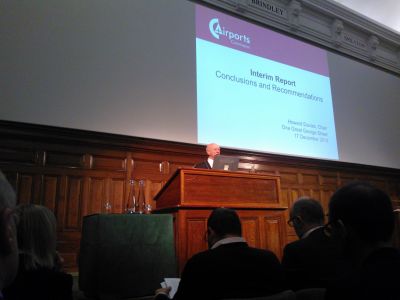20th December, 2013
The Airports Commission’s interim report was launched on 17th December and AEF was in attendance at the launch event at the Institution of Civil Engineers. Our initial response is summarised in our press comment and in an article comparing the report against AEF’s three environmental and social tests. We take a look at the main findings of the report below.

Sir Howard Davies speaking at the Institution of Civil Engineers
The overall conclusion of the report was:
“The Commission has therefore concluded that there is a clear case for one net additional runway in London and the South East, to come into operation by 2030.
In terms of the nature of the capacity that is needed, the Commission does not believe there is a binary choice between providing additional hub capacity or additional point-to-point capacity. Instead, the optimal approach is to continue to invest in an airport system that caters for a range of airline business models.
The Commission’s forecasts also indicate that there is likely to be a demand case for a second additional runway in operation by 2050 or, in some scenarios, earlier.”
The general conclusion was perhaps predictable given the emerging thinking outlined by Sir Howard Davies in October. When the coalition government came to power it confirmed the pre-election policies of the Conservatives and LibDems of no new runways in the southeast of England. But from the start of the current Parliament there has been extensive lobbying from the aviation industry and from within the Conservative party itself for more airport capacity. Soon, the promise was downgraded from no new runways in the southeast of England to no new runways at Heathrow. Then the independent commission was appointed. It is fair to assume that the purpose of the commission was to recommend new runways and thus enable a policy u-turn. If the coalition had intended to keep to its promise of no new runways in the SE, it would not have appointed a commission with the freedom to recommend new runways in the SE.
Much to most people’s surprise, the Commission’s shortlist of options is very short indeed. It consists of just three options:
- Gatwick: a new runway over 3,000m in length spaced sufficiently south of existing runway to permit fully independent operation.
- Heathrow option one: A new 3,500m runway constructed to the northwest of the existing airport, as proposed by Heathrow Airport Ltd, and spaced sufficiently to permit fully independent operation..
- Heathrow option two: an extension of the existing northern runway to the west, as proposed by Heathrow Hub Ltd, lengthening it to at least 6,000m and enabling it to be operated as two separate runways: one for departures and one for arrivals.
AEF and others pressed hard for a ‘no new runways’ option to be shortlisted. This was because the official forecasts of demand show that hardly any traffic would be lost if no new runways were built up to 2030, while existing capacity is currently available to accommodate growth consistent with meeting our climate change objectives. The no new runways option was given short shrift by the Commission although we continue to press fot the no new runways option to become the baseline against which the costs and benefits of all runway options should be assessed.
However, the concept of a Thames Estuary airport has been given a lifeline, even though the commission clearly does not support the idea:
“The Thames Estuary airport options were not at this stage shortlisted. While the potential they offered to reduce aviation noise impacts in the South East of England and to support economic development on the eastern side of London was attractive, they presented many challenges and uncertainties. ..
the cost of an Isle of Grain airport (the most viable of those presented) around five times that of the three short-listed options at up to £112 billion. ..would present major environmental issues .., new surface access infrastructure required would be very substantial .. The Commission intends to carry out additional analysis in respect of the Isle of Grain option in the first half of 2014. On this basis, it will reach a view before the end of the year as to whether such an option would offer a credible proposal for consideration alongside the short-listed options.”
Many commentators claim that the Thames Estuary airport has only been retained by the Commission for political reasons, following Sir Howard’s meetings with George Osborne and Boris Johnson, one of its chief supporters.
AEF will be looking at the interim report in more detail in the New Year and will continue to inform the Airports Commission on the next stage of its work, beginning with responding to the draft appraisal framework in early 2014.
